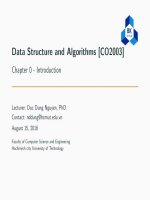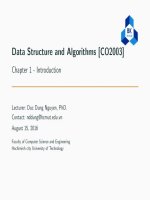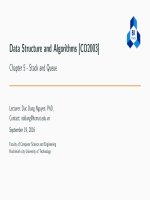C++ programming program design including data structure 7th ch08
Bạn đang xem bản rút gọn của tài liệu. Xem và tải ngay bản đầy đủ của tài liệu tại đây (829.28 KB, 57 trang )
Chapter 8
Arrays and Strings
Objectives
• In this chapter, you will:
–
–
–
–
–
Learn the reasons for arrays
Explore how to declare and manipulate data into arrays
Understand the meaning of ‘‘array index out of bounds’’
Learn how to declare and initialize arrays
Become familiar with the restrictions on array processing
C++ Programming: Program Design Including Data Structures, Seventh Edition
2
Objectives (cont’d.)
–
–
–
–
–
–
Discover how to pass an array as a parameter to a function
Learn how to search an array
Learn how to sort an array
Become aware of auto declarations
Learn about range-based for loops
Learn about C-strings
C++ Programming: Program Design Including Data Structures, Seventh Edition
3
Objectives (cont’d.)
– Examine the use of string functions to process C-strings
– Discover how to input data into—and output data from—a
C-string
– Learn about parallel arrays
– Discover how to manipulate data in a two-dimensional
array
– Learn about multidimensional arrays
C++ Programming: Program Design Including Data Structures, Seventh Edition
4
Introduction
• Simple data type: variables of these types can store
only one value at a time
• Structured data type: a data type in which each data
item is a collection of other data items
C++ Programming: Program Design Including Data Structures, Seventh Edition
5
Arrays
• Array: a collection of a fixed number of components,
all of the same data type
• One-dimensional array: components are arranged in
a list form
• Syntax for declaring a one-dimensional array:
• intExp: any constant expression that evaluates to a
positive integer
C++ Programming: Program Design Including Data Structures, Seventh Edition
6
Accessing Array Components
• General syntax:
• indexExp: called the index
– An expression with a nonnegative integer value
• Value of the index is the position of the item in the
array
• []: array subscripting operator
– Array index always starts at 0
C++ Programming: Program Design Including Data Structures, Seventh Edition
7
Accessing Array Components (cont’d.)
C++ Programming: Program Design Including Data Structures, Seventh Edition
8
Accessing Array Components (cont’d.)
C++ Programming: Program Design Including Data Structures, Seventh Edition
9
Processing One-Dimensional Arrays
• Basic operations on a one-dimensional array:
–
–
–
–
Initializing
Inputting data
Outputting data stored in an array
Finding the largest and/or smallest element
• Each operation requires ability to step through
elements of the array
– Easily accomplished by a loop
C++ Programming: Program Design Including Data Structures, Seventh Edition
10
Processing One-Dimensional Arrays
(cont’d.)
• Given the declaration:
int list[100];
int i;
//array of size 100
• Use a for loop to access array elements:
for (i = 0; i < 100; i++)
cin >> list[i];
C++ Programming: Program Design Including Data Structures, Seventh Edition
//Line 1
//Line 2
11
Array Index Out of Bounds
• Index of an array is in bounds if the index is >=0 and
<= ARRAY_SIZE-1
– Otherwise, the index is out of bounds
• In C++, there is no guard against indices that are out
of bounds
C++ Programming: Program Design Including Data Structures, Seventh Edition
12
Array Initialization During Declaration
• Arrays can be initialized during declaration
– Values are placed between curly braces
– Size determined by the number of initial values in the
braces
• Example:
double sales[] = {12.25, 32.50, 16.90,
23, 45.68};
C++ Programming: Program Design Including Data Structures, Seventh Edition
13
Partial Initialization of Arrays During
Declaration
• The statement:
int list[10] = {0};
–Declares an array of 10 components and initializes all of
them to zero
• The statement:
int list[10] = {8, 5, 12};
–Declares an array of 10 components and initializes
list[0] to 8, list[1] to 5, list[2] to 12
–All other components are initialized to 0
C++ Programming: Program Design Including Data Structures, Seventh Edition
14
Some Restrictions on Array Processing
• Aggregate operation: any operation that manipulates
the entire array as a single unit
– Not allowed on arrays in C++
• Example:
• Solution:
C++ Programming: Program Design Including Data Structures, Seventh Edition
15
Arrays as Parameters to Functions
• Arrays are passed by reference only
• Do not use symbol & when declaring an array as a
formal parameter
• Size of the array is usually omitted
– If provided, it is ignored by the compiler
• Example:
C++ Programming: Program Design Including Data Structures, Seventh Edition
16
Constant Arrays
as Formal Parameters
• Can prevent a function from changing the
actual parameter when passed by reference
– Use const in the declaration of the formal
parameter
• Example:
C++ Programming: Program Design Including Data Structures, Seventh Edition
17
Base Address of an Array and Array in
Computer Memory
• Base address of an array: address (memory location)
of the first array component
• Example:
– If list is a one-dimensional array, its base address is the
address of list[0]
• When an array is passed as a parameter, the base
address of the actual array is passed to the formal
parameter
C++ Programming: Program Design Including Data Structures, Seventh Edition
18
Functions Cannot Return a Value of
the Type Array
• C++ does not allow functions to return a value of
type array
C++ Programming: Program Design Including Data Structures, Seventh Edition
19
Integral Data Type
and Array Indices
• C++ allows any integral type to be used as an array
index
– Improves code readability
• Example:
C++ Programming: Program Design Including Data Structures, Seventh Edition
20
Other Ways to Declare Arrays
• Examples:
C++ Programming: Program Design Including Data Structures, Seventh Edition
21
Searching an Array
for a Specific Item
• Sequential search (or linear search):
– Searching a list for a given item, starting from the first
array element
– Compare each element in the array with value being
searched for
– Continue the search until item is found or no more data is
left in the list
C++ Programming: Program Design Including Data Structures, Seventh Edition
22
Sorting
• Selection sort: rearrange the list by selecting an
element and moving it to its proper position
• Steps:
– Find the smallest element in the unsorted portion of the
list
– Move it to the top of the unsorted portion by swapping
with the element currently there
– Start again with the rest of the list
C++ Programming: Program Design Including Data Structures, Seventh Edition
23
Selection Sort (cont’d.)
C++ Programming: Program Design Including Data Structures, Seventh Edition
24
Auto Declaration and Range-Based
For Loops
• C++11 allows auto declaration of variables
– Data type does not need to be specified
auto num = 15; // num is assumed int
• Range-based for loop
sum = 0;
for (double num : list) // For each num
sum = sum + num;
// in list
C++ Programming: Program Design Including Data Structures, Seventh Edition
25









